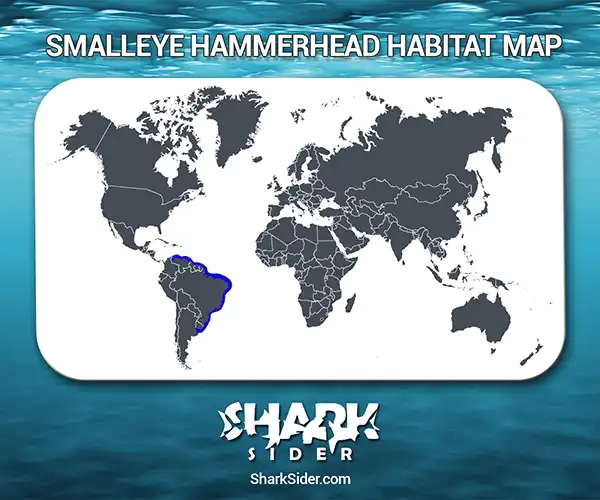Smalleye hammerheads are a small species of sharks belonging to the family Sphyrnidae. These hammerhead sharks have prominent, slightly arched cephalophoils (outward head extensions). Their eyes are smaller than other hammerheads- hence earning them their name.
Smalleye Hammerhead Scientific Classification |
|
| Kingdom | Animalia |
| Phylum | Chordata |
| Class | Chondrichthyes |
| Order | Carcharhiniformes |
| Family | Sphyrnidae |
| Genus | Sphyrna |
| Scientific Name | Sphyrna tudes |
Description
These sharks generally measure 3.9–4.3 ft but have been known to reach lengths of 4.9 ft. They are one of the smaller members of their family, weighing not more than 20 lbs on average.
They have a unique color pattern. Their back and dorsal fins appear gray or yellowish-gray. Whereas a bright gold metallic or orange-yellow iridescent hue is observed on their pectoral, pelvic, and anal fins. Newborn sharks are born with a gray dorsal body surface and white on their ventral side. By the time these sharks are 18 inches long, their underside is yellowish, which turns to orange by the time when they are 20 inches long. The golden color is most luminous in juvenile sharks measuring 22-28 inches long. Still, it tends to fade away when they reach sexual maturity.
These sharks have oval-shaped dermal denticles with five horizontal ridges leading to marginal teeth.
They have a streamlined body shape with wide cephalofoils shaped like mallets (measuring roughly 30% of their total body length) on either side of their head. These cephalofoils are longer and more arched in newborns.
Eyes covered with nictitating membranes are present on the sides of these cephalofoils. Positioned just inside the eyes are a pair of nostrils. A well-developed groove of each nostril runs towards the middle of the cephalofoil.
The sharks have a strongly curved mouth consisting of 15-16 upper rows and 15-17 lower tooth rows on either jaw. Each tooth is either angled (in the upper jaw) or upright (in the lower jaw) and has a single narrow cusp with smooth or weakly serrated edges.
They have a tall, sickle-shaped dorsal fin that begins just behind the base of the pectoral fins. The first dorsal fin in their body is larger than the second, with the latter consisting of a trailing concave margin. The trailing margins of the pelvic fins are nearly straight. These sharks have a tall anal fin and a caudal fin consisting of a distinct notch close to the tip of the upper lobe and a prominent lower lobe.
Where do they live
Map Of The Smalleye Hammerhead Shark’s Habitat

These sharks live in subtropical waters off the eastern coast of South America, from Uruguay to Venezuela. This species is dominant and abundant in the Orinoco delta southeast of Trinidad.
They inhabit muddy coastal waters with depths of 131 ft. Newborn pups and juveniles live in shallow waters until they are 16 inches long, after which they swim into deeper waters. Adult females were found to inhabit depths of 30–59 ft, while larger juveniles as well as the male smalleye hammerhead sharks dwell at depths of 89-118 ft. They don’t have a problem thriving in brackish water, tolerant of a salinity range around 20 to 34 ppt.
Behavior
Dietary
Smalleye hammerheads feed on shrimps, swimming crabs, squids, and newborn scallops. They also consume bony fishes such as catfishes and their eggs.
The distinct golden coloration of their body is speculated by scientists to come from a pigment present in shrimps, the sea catfish, as well as their eggs which these sharks feed on.
Reproductory
The smalleye hammerhead follows a viviparous mode of reproduction. A placental connection forms out of the depleted egg yolk after the developing embryos are done consuming the yolk. Gaseous exchange and nourishment take place via this placental connection. Mature females possess a pair of functional uteri and a single functional ovary.
Females can bear young every year because pregnancy happens simultaneously with ovulation.
Mating period, sexual maturity, and litter size vary across its range. In Trinidad, males and females reach sexual maturity at a length of 31 and 39 inches. The mating period takes place between August and September. 5-12 pups are born in a litter after a 10-month pregnancy. These pups are 0.98 ft in length at the time of birth.
In the northern Brazilian state of Maranhão, individuals are relatively long, with males maturing at lengths of 36 inches and females at over 40 inches. Litter size consists of up to 19 pups. Gestating females are found twice a year, from June – October and January – April.
Adaptations
These sharks possess small evolved eyes to help them detect and capture prey in muddy, shallow areas with levels of high turbidity near low coastal waters. This adaptation also gives these sharks lesser competition for food.
Interactions with humans
Because of their small size and timid nature, these sharks do not threaten humans. They are sometimes accidental victims of by-catch by shrimp boat trawls, line gear, and other fisheries. Its unique head structure makes this species an attractive catch. Still, besides its fins and meat, it lacks commercial and economic importance.
A low reproductive rate and the intense fishing pressure they face in current times have resulted in the smalleye hammerheads being listed as a ‘Vulnerable’ species by the IUCN.
No conservation or management schemes are currently underway to protect these sharks.
